Alfa Romeo Giulietta 2016 Owner's Manual
Manufacturer: ALFA ROMEO, Model Year: 2016, Model line: Giulietta, Model: Alfa Romeo Giulietta 2016Pages: 288, PDF Size: 7.34 MB
Page 211 of 288
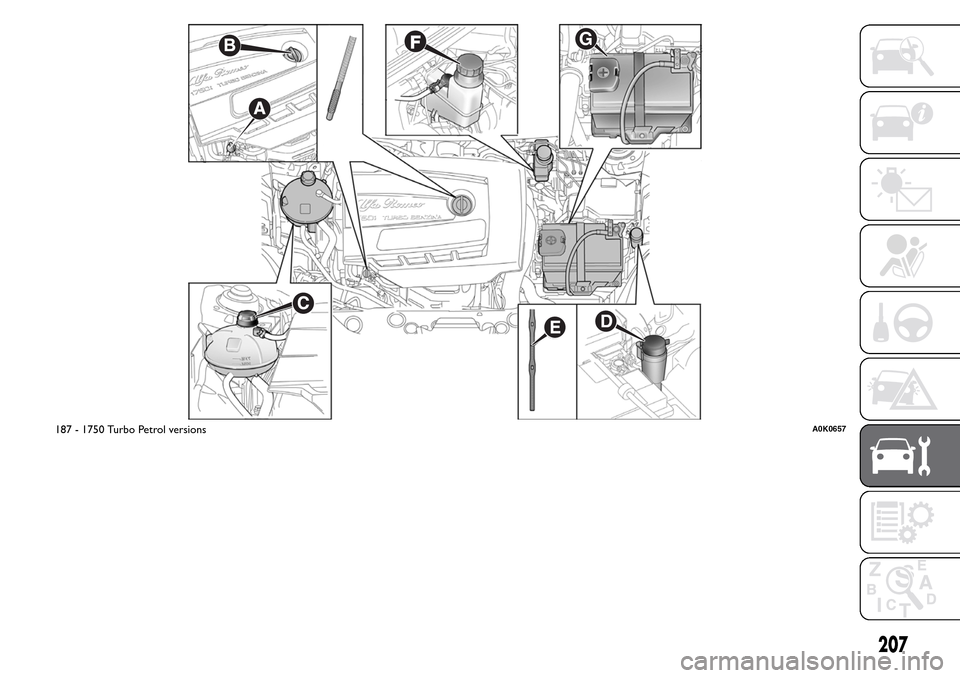
.
G
187 - 1750 Turbo Petrol versionsA0K0657
207
Page 212 of 288
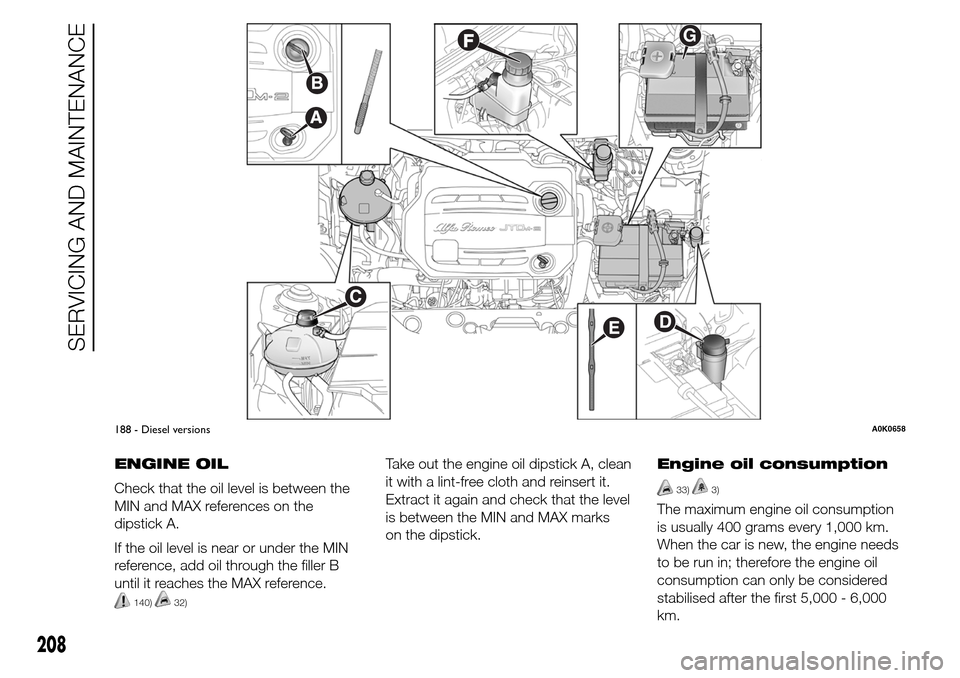
ENGINE OIL
Check that the oil level is between the
MIN and MAX references on the
dipstick A.
If the oil level is near or under the MIN
reference, add oil through the filler B
until it reaches the MAX reference.
140)32)
Take out the engine oil dipstick A, clean
it with a lint-free cloth and reinsert it.
Extract it again and check that the level
is between the MIN and MAX marks
on the dipstick.Engine oil consumption
33)3)
The maximum engine oil consumption
is usually 400 grams every 1,000 km.
When the car is new, the engine needs
to be run in; therefore the engine oil
consumption can only be considered
stabilised after the first 5,000 - 6,000
km.
G
188 - Diesel versionsA0K0658
208
SERVICING AND MAINTENANCE
Page 213 of 288
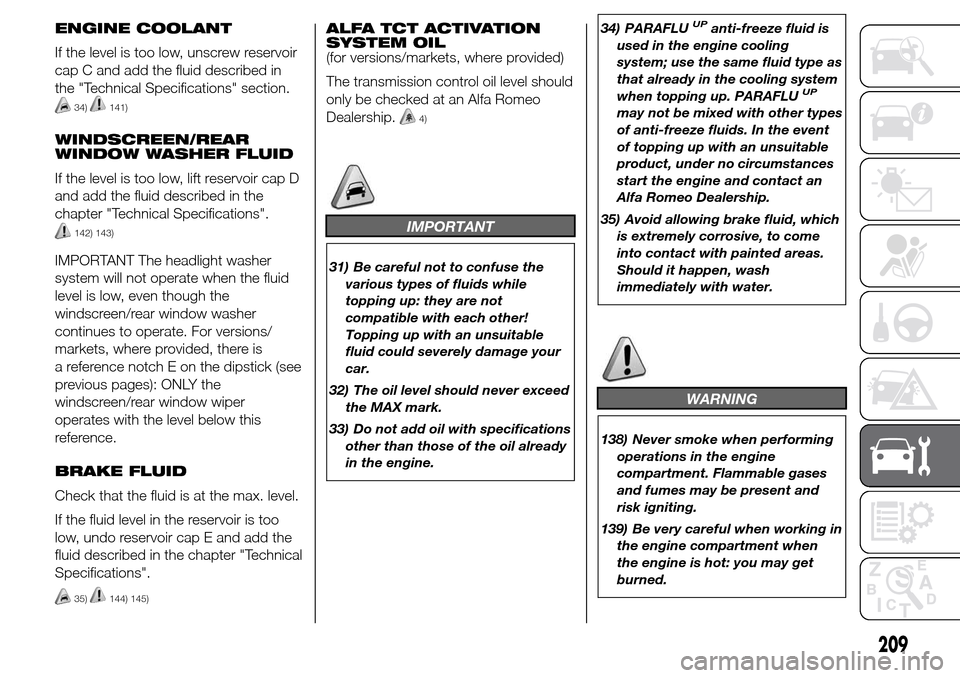
ENGINE COOLANT
If the level is too low, unscrew reservoir
cap C and add the fluid described in
the "Technical Specifications" section.
34)141)
WINDSCREEN/REAR
WINDOW WASHER FLUID
If the level is too low, lift reservoir cap D
and add the fluid described in the
chapter "Technical Specifications".
142) 143)
IMPORTANT The headlight washer
system will not operate when the fluid
level is low, even though the
windscreen/rear window washer
continues to operate. For versions/
markets, where provided, there is
a reference notch E on the dipstick (see
previous pages): ONLY the
windscreen/rear window wiper
operates with the level below this
reference.
BRAKE FLUID
Check that the fluid is at the max. level.
If the fluid level in the reservoir is too
low, undo reservoir cap E and add the
fluid described in the chapter "Technical
Specifications".
35)144) 145)
ALFA TCT ACTIVATION
SYSTEM OIL
(for versions/markets, where provided)
The transmission control oil level should
only be checked at an Alfa Romeo
Dealership.
4)
IMPORTANT
31) Be careful not to confuse the
various types of fluids while
topping up: they are not
compatible with each other!
Topping up with an unsuitable
fluid could severely damage your
car.
32) The oil level should never exceed
the MAX mark.
33) Do not add oil with specifications
other than those of the oil already
in the engine.34) PARAFLU
UPanti-freeze fluid is
used in the engine cooling
system; use the same fluid type as
that already in the cooling system
when topping up. PARAFLU
UP
may not be mixed with other types
of anti-freeze fluids. In the event
of topping up with an unsuitable
product, under no circumstances
start the engine and contact an
Alfa Romeo Dealership.
35) Avoid allowing brake fluid, which
is extremely corrosive, to come
into contact with painted areas.
Should it happen, wash
immediately with water.
WARNING
138) Never smoke when performing
operations in the engine
compartment. Flammable gases
and fumes may be present and
risk igniting.
139) Be very careful when working in
the engine compartment when
the engine is hot: you may get
burned.
209
Page 214 of 288
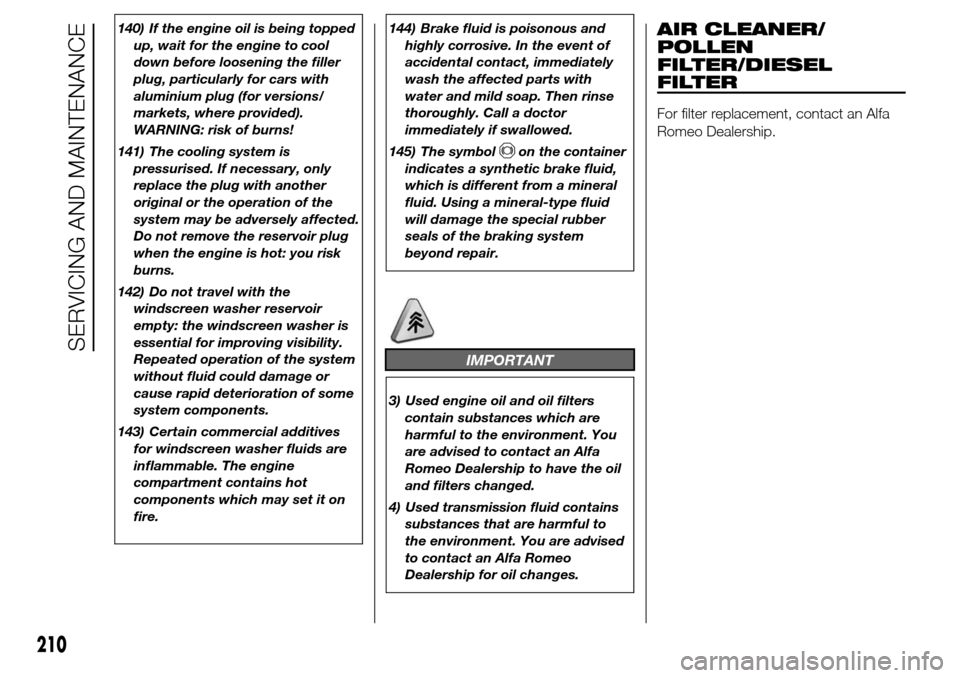
140) If the engine oil is being topped
up, wait for the engine to cool
down before loosening the filler
plug, particularly for cars with
aluminium plug (for versions/
markets, where provided).
WARNING: risk of burns!
141) The cooling system is
pressurised. If necessary, only
replace the plug with another
original or the operation of the
system may be adversely affected.
Do not remove the reservoir plug
when the engine is hot: you risk
burns.
142) Do not travel with the
windscreen washer reservoir
empty: the windscreen washer is
essential for improving visibility.
Repeated operation of the system
without fluid could damage or
cause rapid deterioration of some
system components.
143) Certain commercial additives
for windscreen washer fluids are
inflammable. The engine
compartment contains hot
components which may set it on
fire.144) Brake fluid is poisonous and
highly corrosive. In the event of
accidental contact, immediately
wash the affected parts with
water and mild soap. Then rinse
thoroughly. Call a doctor
immediately if swallowed.
145) The symbol
on the container
indicates a synthetic brake fluid,
which is different from a mineral
fluid. Using a mineral-type fluid
will damage the special rubber
seals of the braking system
beyond repair.
IMPORTANT
3) Used engine oil and oil filters
contain substances which are
harmful to the environment. You
are advised to contact an Alfa
Romeo Dealership to have the oil
and filters changed.
4) Used transmission fluid contains
substances that are harmful to
the environment. You are advised
to contact an Alfa Romeo
Dealership for oil changes.
AIR CLEANER/
POLLEN
FILTER/DIESEL
FILTER
For filter replacement, contact an Alfa
Romeo Dealership.
210
SERVICING AND MAINTENANCE
Page 215 of 288
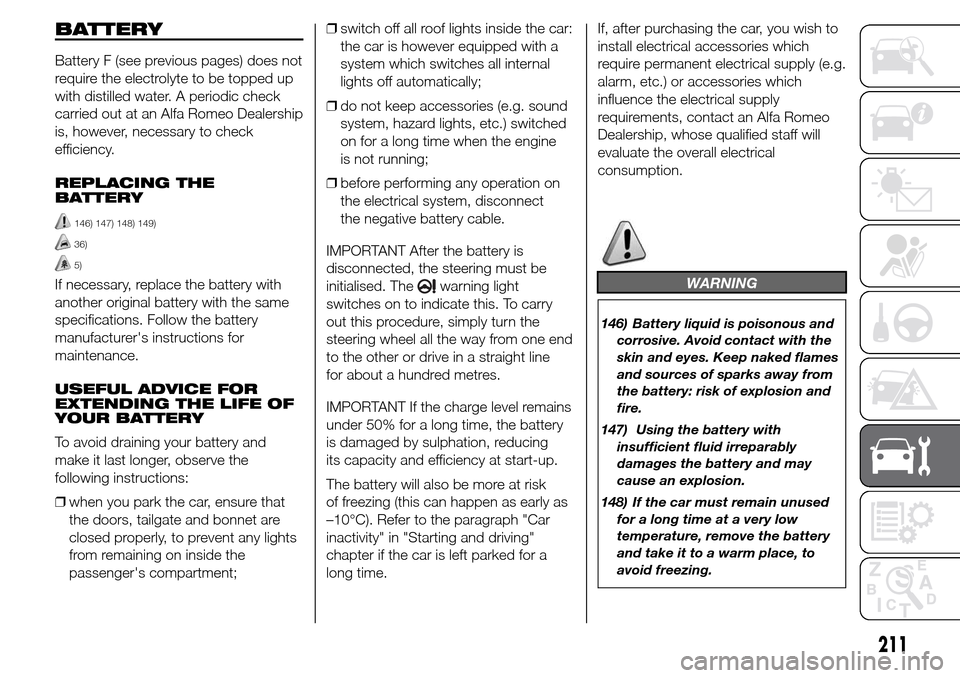
BATTERY
Battery F (see previous pages) does not
require the electrolyte to be topped up
with distilled water. A periodic check
carried out at an Alfa Romeo Dealership
is, however, necessary to check
efficiency.
REPLACING THE
BATTERY
146) 147) 148) 149)
36)
5)
If necessary, replace the battery with
another original battery with the same
specifications. Follow the battery
manufacturer's instructions for
maintenance.
USEFUL ADVICE FOR
EXTENDING THE LIFE OF
YOUR BATTERY
To avoid draining your battery and
make it last longer, observe the
following instructions:
❒when you park the car, ensure that
the doors, tailgate and bonnet are
closed properly, to prevent any lights
from remaining on inside the
passenger's compartment;❒switch off all roof lights inside the car:
the car is however equipped with a
system which switches all internal
lights off automatically;
❒do not keep accessories (e.g. sound
system, hazard lights, etc.) switched
on for a long time when the engine
is not running;
❒before performing any operation on
the electrical system, disconnect
the negative battery cable.
IMPORTANT After the battery is
disconnected, the steering must be
initialised. Thewarning light
switches on to indicate this. To carry
out this procedure, simply turn the
steering wheel all the way from one end
to the other or drive in a straight line
for about a hundred metres.
IMPORTANT If the charge level remains
under 50% for a long time, the battery
is damaged by sulphation, reducing
its capacity and efficiency at start-up.
The battery will also be more at risk
of freezing (this can happen as early as
–10°C). Refer to the paragraph "Car
inactivity" in "Starting and driving"
chapter if the car is left parked for a
long time.If, after purchasing the car, you wish to
install electrical accessories which
require permanent electrical supply (e.g.
alarm, etc.) or accessories which
influence the electrical supply
requirements, contact an Alfa Romeo
Dealership, whose qualified staff will
evaluate the overall electrical
consumption.WARNING
146) Battery liquid is poisonous and
corrosive. Avoid contact with the
skin and eyes. Keep naked flames
and sources of sparks away from
the battery: risk of explosion and
fire.
147) Using the battery with
insufficient fluid irreparably
damages the battery and may
cause an explosion.
148) If the car must remain unused
for a long time at a very low
temperature, remove the battery
and take it to a warm place, to
avoid freezing.
211
Page 216 of 288
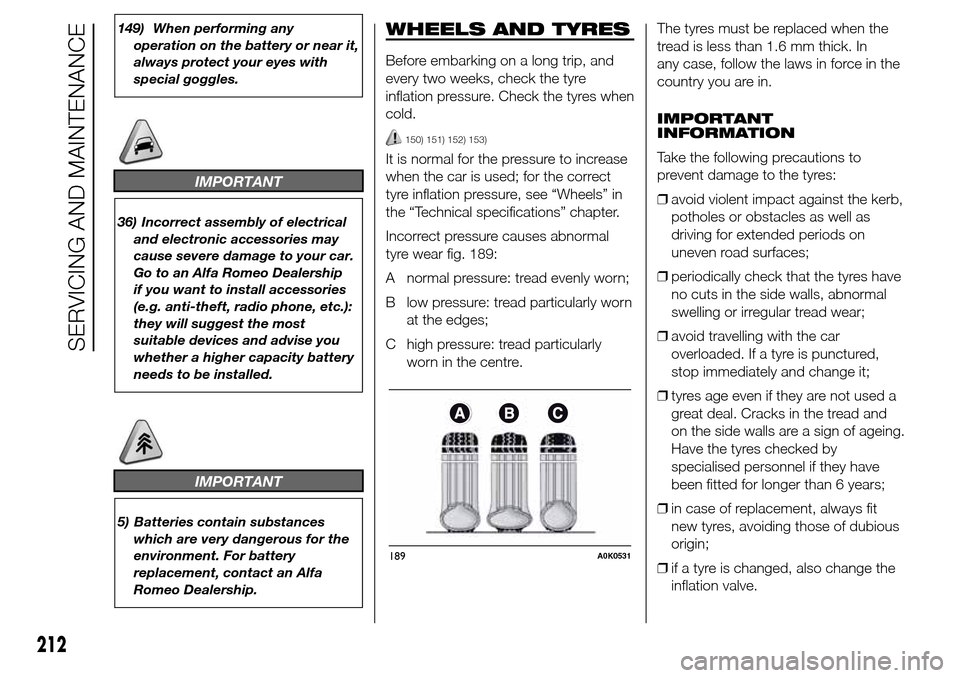
149) When performing any
operation on the battery or near it,
always protect your eyes with
special goggles.
IMPORTANT
36) Incorrect assembly of electrical
and electronic accessories may
cause severe damage to your car.
Go to an Alfa Romeo Dealership
if you want to install accessories
(e.g. anti-theft, radio phone, etc.):
they will suggest the most
suitable devices and advise you
whether a higher capacity battery
needs to be installed.
IMPORTANT
5) Batteries contain substances
which are very dangerous for the
environment. For battery
replacement, contact an Alfa
Romeo Dealership.
WHEELS AND TYRES
Before embarking on a long trip, and
every two weeks, check the tyre
inflation pressure. Check the tyres when
cold.
150) 151) 152) 153)
It is normal for the pressure to increase
when the car is used; for the correct
tyre inflation pressure, see “Wheels” in
the “Technical specifications” chapter.
Incorrect pressure causes abnormal
tyre wear fig. 189:
A normal pressure: tread evenly worn;
B low pressure: tread particularly worn
at the edges;
C high pressure: tread particularly
worn in the centre.The tyres must be replaced when the
tread is less than 1.6 mm thick. In
any case, follow the laws in force in the
country you are in.
IMPORTANT
INFORMATION
Take the following precautions to
prevent damage to the tyres:
❒avoid violent impact against the kerb,
potholes or obstacles as well as
driving for extended periods on
uneven road surfaces;
❒periodically check that the tyres have
no cuts in the side walls, abnormal
swelling or irregular tread wear;
❒avoid travelling with the car
overloaded. If a tyre is punctured,
stop immediately and change it;
❒tyres age even if they are not used a
great deal. Cracks in the tread and
on the side walls are a sign of ageing.
Have the tyres checked by
specialised personnel if they have
been fitted for longer than 6 years;
❒in case of replacement, always fit
new tyres, avoiding those of dubious
origin;
❒if a tyre is changed, also change the
inflation valve.
189A0K0531
212
SERVICING AND MAINTENANCE
Page 217 of 288
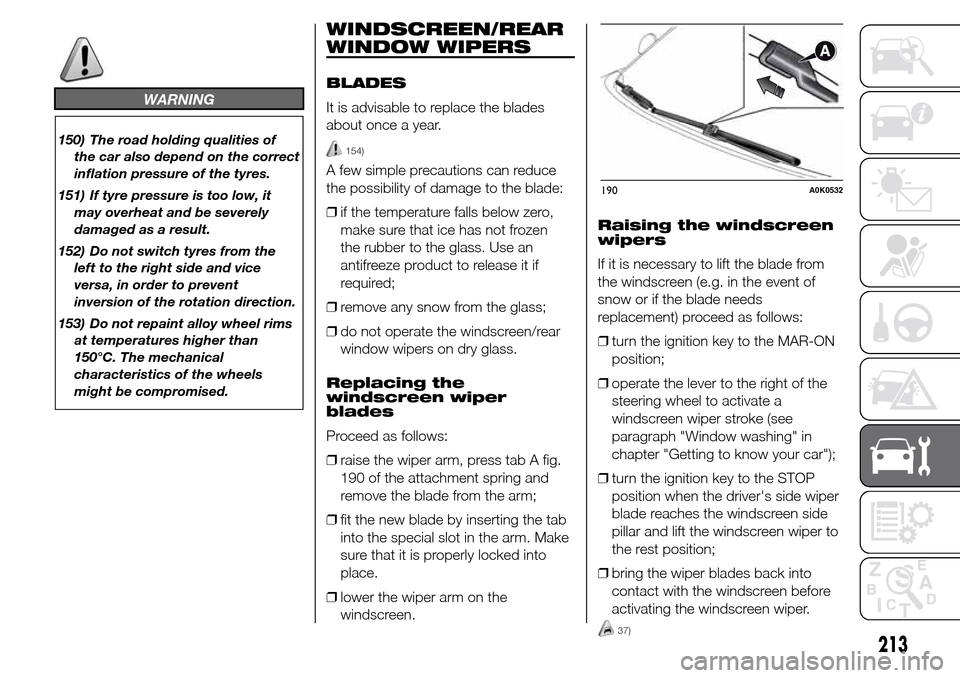
WARNING
150) The road holding qualities of
the car also depend on the correct
inflation pressure of the tyres.
151) If tyre pressure is too low, it
may overheat and be severely
damaged as a result.
152) Do not switch tyres from the
left to the right side and vice
versa, in order to prevent
inversion of the rotation direction.
153) Do not repaint alloy wheel rims
at temperatures higher than
150°C. The mechanical
characteristics of the wheels
might be compromised.
WINDSCREEN/REAR
WINDOW WIPERS
BLADES
It is advisable to replace the blades
about once a year.
154)
A few simple precautions can reduce
the possibility of damage to the blade:
❒if the temperature falls below zero,
make sure that ice has not frozen
the rubber to the glass. Use an
antifreeze product to release it if
required;
❒remove any snow from the glass;
❒do not operate the windscreen/rear
window wipers on dry glass.
Replacing the
windscreen wiper
blades
Proceed as follows:
❒raise the wiper arm, press tab A fig.
190 of the attachment spring and
remove the blade from the arm;
❒fit the new blade by inserting the tab
into the special slot in the arm. Make
sure that it is properly locked into
place.
❒lower the wiper arm on the
windscreen.Raising the windscreen
wipers
If it is necessary to lift the blade from
the windscreen (e.g. in the event of
snow or if the blade needs
replacement) proceed as follows:
❒turn the ignition key to the MAR-ON
position;
❒operate the lever to the right of the
steering wheel to activate a
windscreen wiper stroke (see
paragraph "Window washing" in
chapter "Getting to know your car");
❒turn the ignition key to the STOP
position when the driver's side wiper
blade reaches the windscreen side
pillar and lift the windscreen wiper to
the rest position;
❒bring the wiper blades back into
contact with the windscreen before
activating the windscreen wiper.
190A0K0532
213
37)
Page 218 of 288
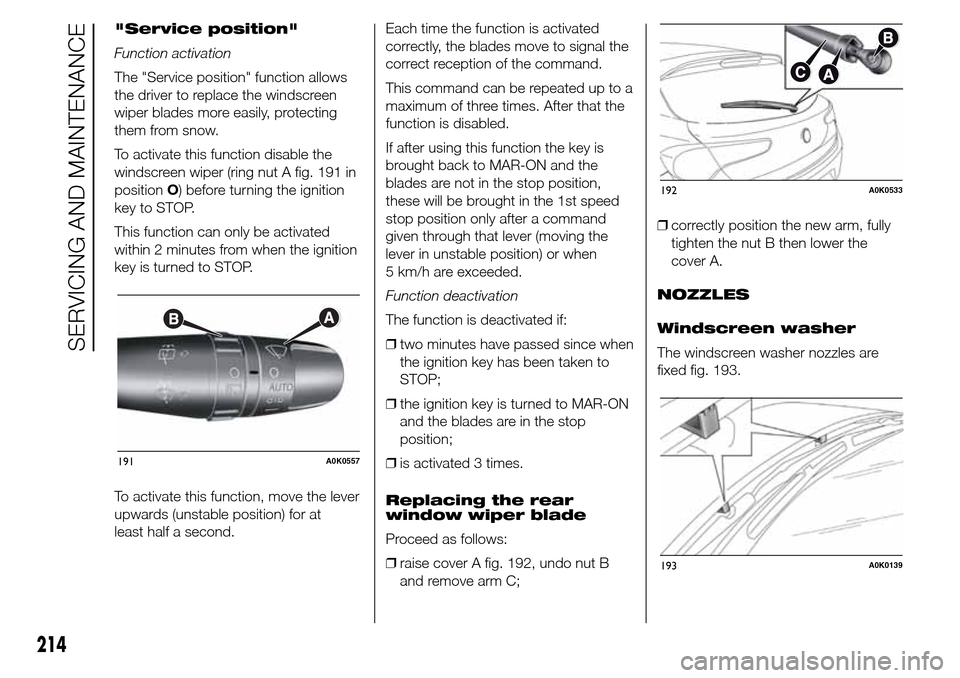
"Service position"
Function activation
The "Service position" function allows
the driver to replace the windscreen
wiper blades more easily, protecting
them from snow.
To activate this function disable the
windscreen wiper (ring nut A fig. 191 in
positionO) before turning the ignition
key to STOP.
This function can only be activated
within 2 minutes from when the ignition
key is turned to STOP.
To activate this function, move the lever
upwards (unstable position) for at
least half a second.Each time the function is activated
correctly, the blades move to signal the
correct reception of the command.
This command can be repeated up to a
maximum of three times. After that the
function is disabled.
If after using this function the key is
brought back to MAR-ON and the
blades are not in the stop position,
these will be brought in the 1st speed
stop position only after a command
given through that lever (moving the
lever in unstable position) or when
5 km/h are exceeded.
Function deactivation
The function is deactivated if:
❒two minutes have passed since when
the ignition key has been taken to
STOP;
❒the ignition key is turned to MAR-ON
and the blades are in the stop
position;
❒is activated 3 times.
Replacing the rear
window wiper blade
Proceed as follows:
❒raise cover A fig. 192, undo nut B
and remove arm C;❒correctly position the new arm, fully
tighten the nut B then lower the
cover A.
NOZZLES
Windscreen washer
The windscreen washer nozzles are
fixed fig. 193.
191A0K0557
192A0K0533
193A0K0139
214
SERVICING AND MAINTENANCE
Page 219 of 288
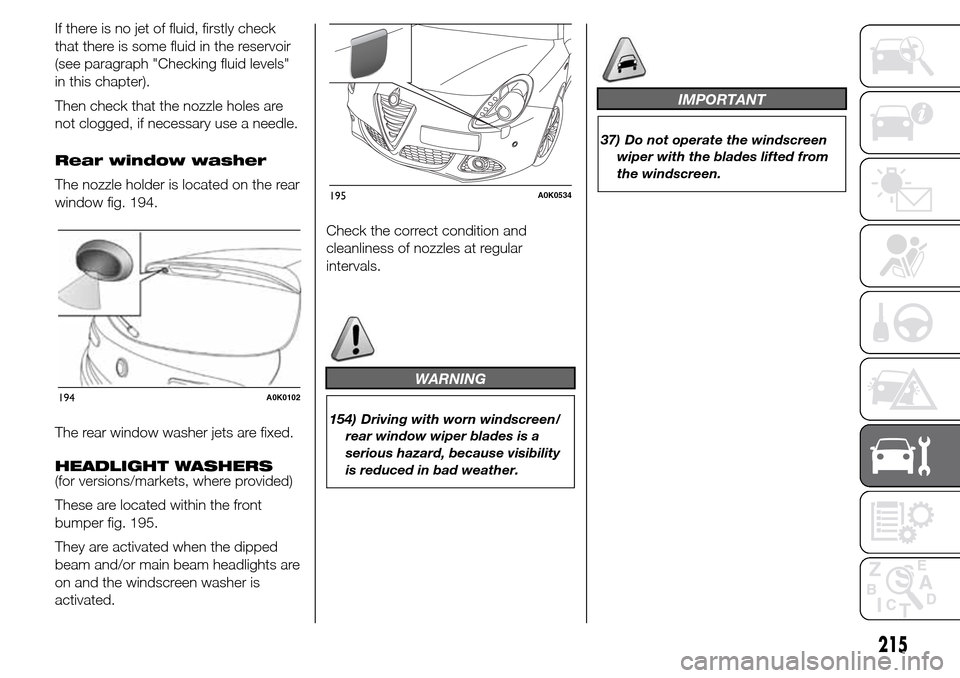
If there is no jet of fluid, firstly check
that there is some fluid in the reservoir
(see paragraph "Checking fluid levels"
in this chapter).
Then check that the nozzle holes are
not clogged, if necessary use a needle.
Rear window washer
The nozzle holder is located on the rear
window fig. 194.
The rear window washer jets are fixed.
HEADLIGHT WASHERS
(for versions/markets, where provided)
These are located within the front
bumper fig. 195.
They are activated when the dipped
beam and/or main beam headlights are
on and the windscreen washer is
activated.Check the correct condition and
cleanliness of nozzles at regular
intervals.
WARNING
154) Driving with worn windscreen/
rear window wiper blades is a
serious hazard, because visibility
is reduced in bad weather.
IMPORTANT
37) Do not operate the windscreen
wiper with the blades lifted from
the windscreen.
194A0K0102
195A0K0534
215
Page 220 of 288
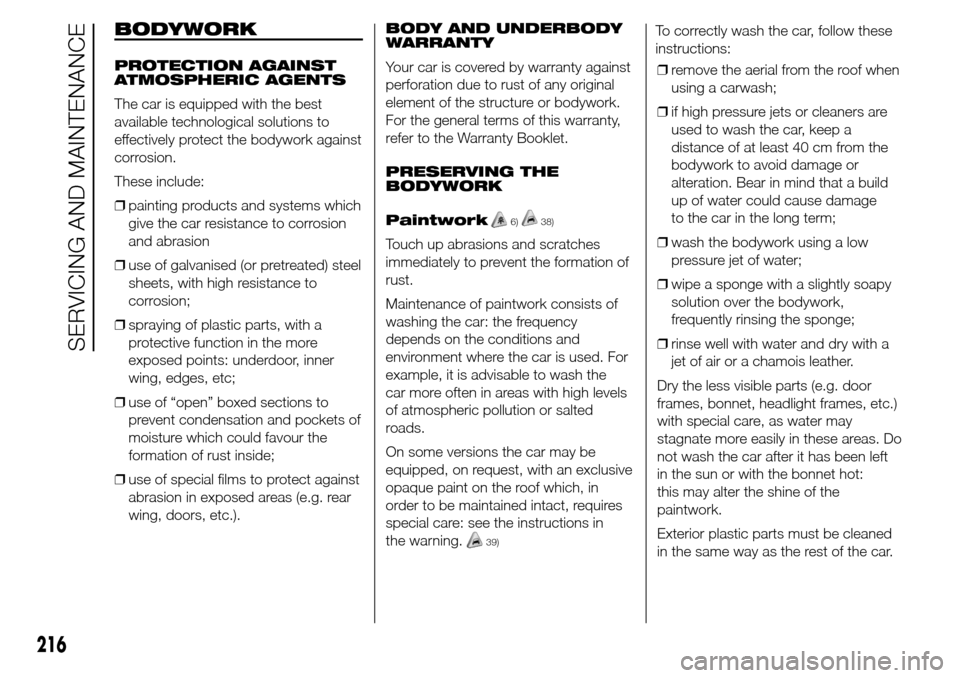
BODYWORK
PROTECTION AGAINST
ATMOSPHERIC AGENTS
The car is equipped with the best
available technological solutions to
effectively protect the bodywork against
corrosion.
These include:
❒painting products and systems which
give the car resistance to corrosion
and abrasion
❒use of galvanised (or pretreated) steel
sheets, with high resistance to
corrosion;
❒spraying of plastic parts, with a
protective function in the more
exposed points: underdoor, inner
wing, edges, etc;
❒use of “open” boxed sections to
prevent condensation and pockets of
moisture which could favour the
formation of rust inside;
❒use of special films to protect against
abrasion in exposed areas (e.g. rear
wing, doors, etc.).BODY AND UNDERBODY
WARRANTY
Your car is covered by warranty against
perforation due to rust of any original
element of the structure or bodywork.
For the general terms of this warranty,
refer to the Warranty Booklet.
PRESERVING THE
BODYWORK
Paintwork
6)38)
Touch up abrasions and scratches
immediately to prevent the formation of
rust.
Maintenance of paintwork consists of
washing the car: the frequency
depends on the conditions and
environment where the car is used. For
example, it is advisable to wash the
car more often in areas with high levels
of atmospheric pollution or salted
roads.
On some versions the car may be
equipped, on request, with an exclusive
opaque paint on the roof which, in
order to be maintained intact, requires
special care: see the instructions in
the warning.
39)
To correctly wash the car, follow these
instructions:
❒remove the aerial from the roof when
using a carwash;
❒if high pressure jets or cleaners are
used to wash the car, keep a
distance of at least 40 cm from the
bodywork to avoid damage or
alteration. Bear in mind that a build
up of water could cause damage
to the car in the long term;
❒wash the bodywork using a low
pressure jet of water;
❒wipe a sponge with a slightly soapy
solution over the bodywork,
frequently rinsing the sponge;
❒rinse well with water and dry with a
jet of air or a chamois leather.
Dry the less visible parts (e.g. door
frames, bonnet, headlight frames, etc.)
with special care, as water may
stagnate more easily in these areas. Do
not wash the car after it has been left
in the sun or with the bonnet hot:
this may alter the shine of the
paintwork.
Exterior plastic parts must be cleaned
in the same way as the rest of the car.
216
SERVICING AND MAINTENANCE